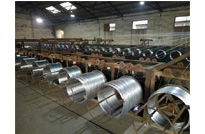
At present, most domestic hot-dip galvanizing, galvanizing, electro galvanized steel wire, and electroplating of multiple alloys. The removal of rust on the surface of steel is generally performed by hydrochloric acid pickling. Waste acid is one of the important pollution sources in galvanizing wastewater. The rust-removal mechanism of hydrochloric acid shows that in order to make the steel surface clean after pickling in the shortest time, the key lies in the concentration of hydrochloric acid, the FeCl₂ content and its solubility at this concentration. In continuous production, in order to ensure the effect of pickling, it is necessary to prevent the concentration of the acid solution and the height of the pickling solution from changing during operation, and to replenish the new acid in time. How to improve the utilization rate of hydrochloric acid and reduce the acid consumption in the production of galvanized steel wire is an important issue for galvanizing enterprises.
First, before the pickling process is improved
Before the improvement of the hot dipped galvanized steel wire production line, the annealed steel wire and the non-annealed steel wire were processed at the same time. After the two types of steel wires were processed, one pickling tank was used. The pickling tank is equipped with a level gauge to monitor the acid level in the tank. The pickling tank adopts three sections of wave-type washing. From the direction of the wire entry, the concentration of each section gradually increases.
1.1 Acid supplement
According to the acid concentration of the acid pickling tank that is regularly tested by the quality inspection department, the operator of the production line starts the acid adding pump with a time relay control, and adds new hydrochloric acid to the third highest concentration section. The overflow hole flows through the other two sections in sequence, and finally the excess acid flows out from the first section with the lowest concentration. The time relay is used to control the running time of the acid pump. The time relay is set to 5s to achieve “a small amount of multiple additions”, which reduces acid overflow. The overflow and discharged waste acid liquid directly enters the pickling wastewater system and flows back to the wastewater treatment station.
1.2 Problems
The scale on the surface of non-annealed steel wire is significantly less than that on soft black annealed steel wire. Under the same heat treatment conditions, the scale on the surface of high-carbon steel wire is more difficult to remove than that of low-carbon steel wire. Multiple products are pickled at the same time. The concentration of hydrochloric acid can only be set according to the highest pickling solution requirements, resulting in low utilization of hydrochloric acid.
According to the chemical test results, artificial acid addition is performed, and the amount of acid addition cannot be accurately controlled. After the new acid is added, the peak concentration of the acid solution is higher. During one acid addition period, the concentration of hydrochloric acid fluctuates greatly; human factors have a large effect, and the acid addition system is stable Poor performance; low degree of automation and low work efficiency.
There is no system for recovering waste acid liquid, which causes the acid content in the pickling wastewater to be too high, which increases the operating cost of wastewater treatment.

